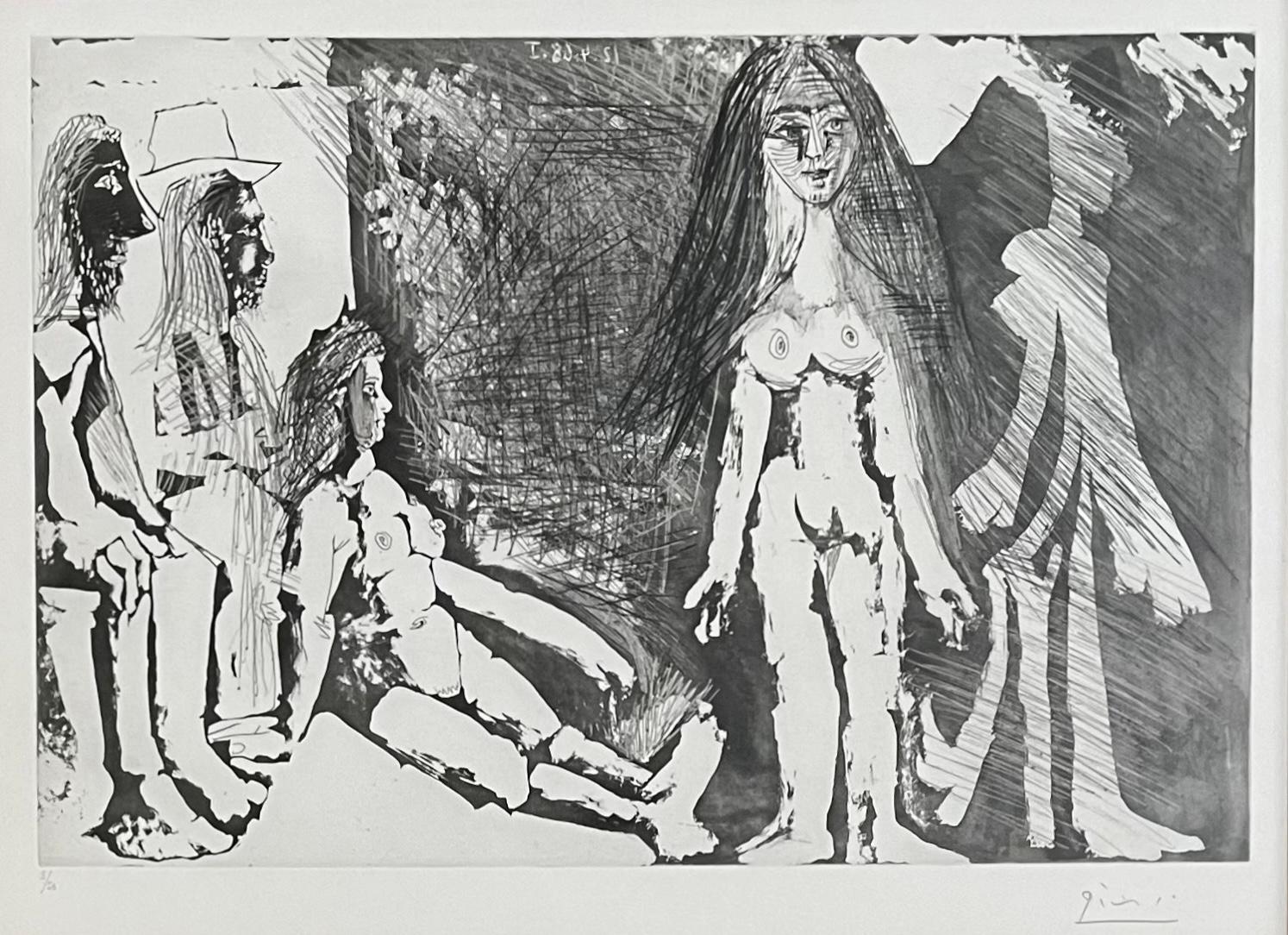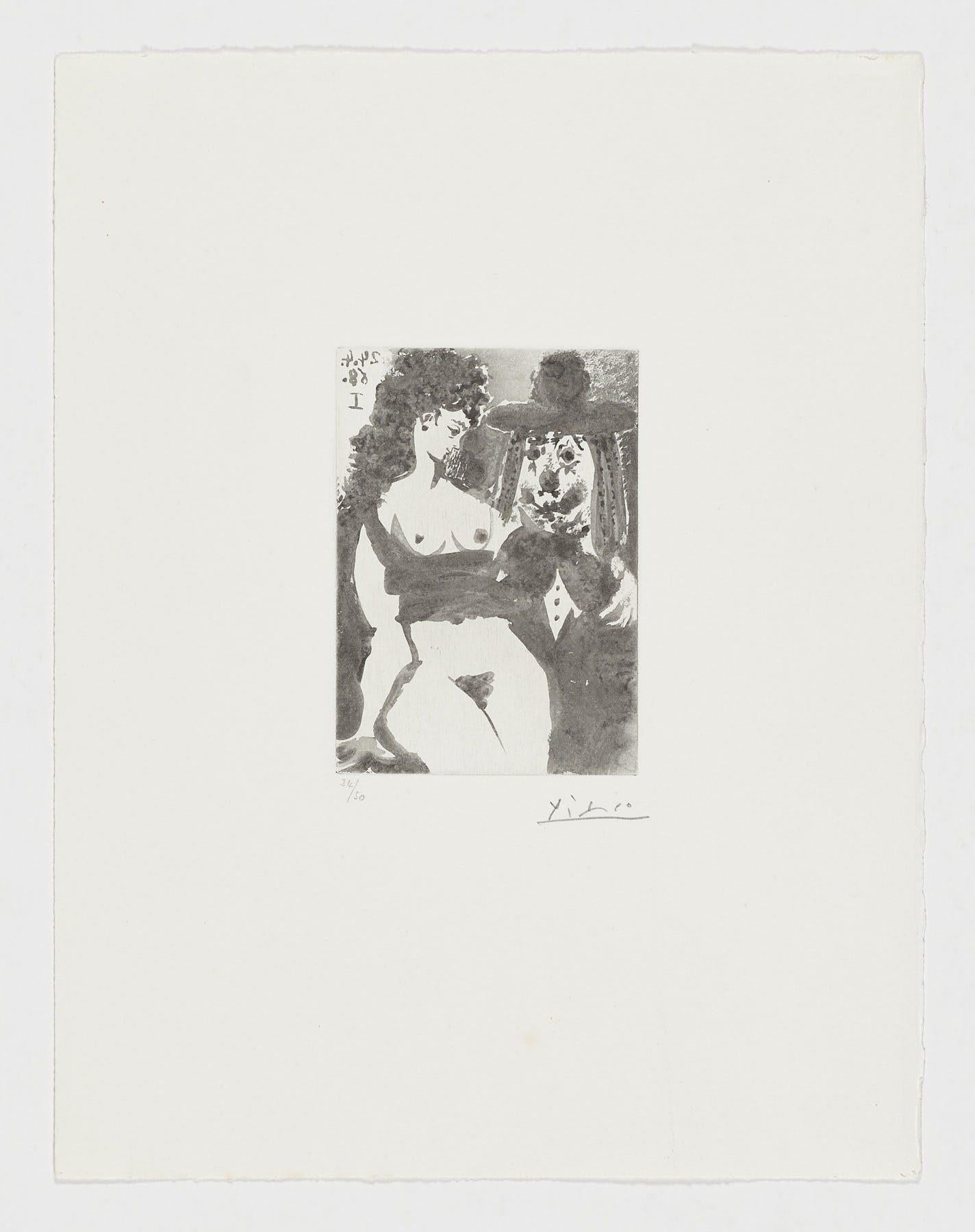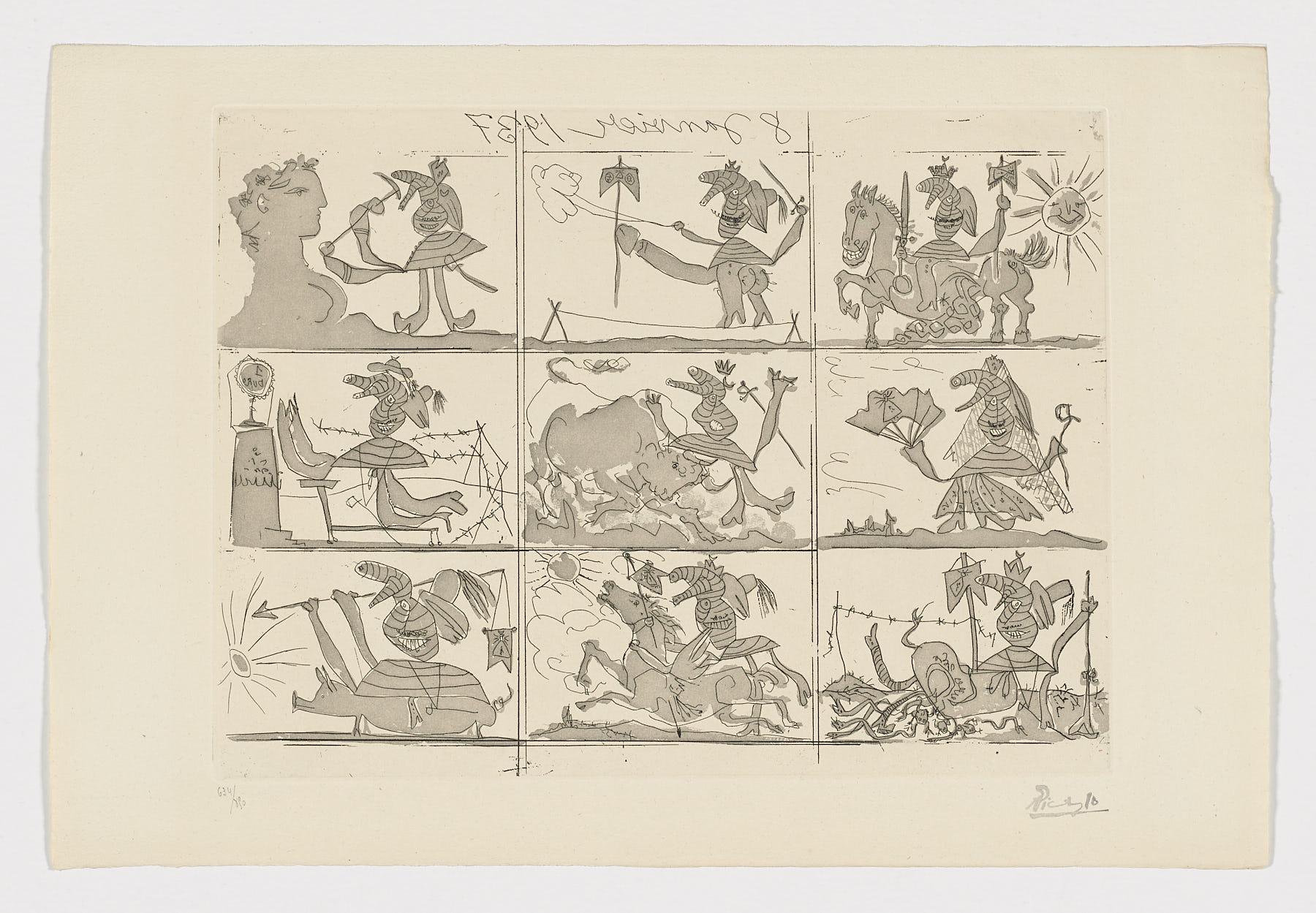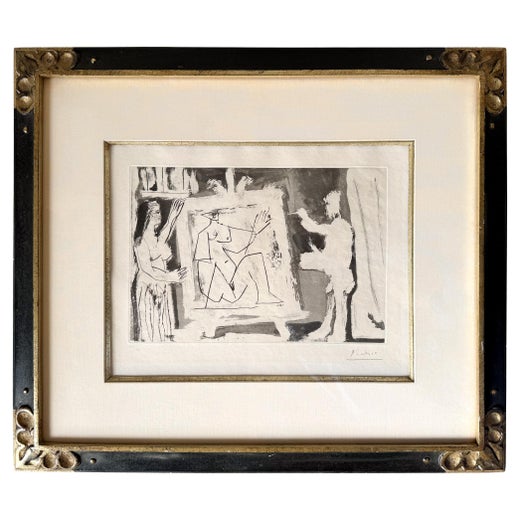Pablo PicassoPablo Ruiz Picasso Spanish 1968 signed limited edition original art print n81968
1968
About the Item
- Creator:Pablo Picasso (1881-1973, Spanish)
- Creation Year:1968
- Dimensions:Height: 9.6 in (24.39 cm)Width: 12.9 in (32.77 cm)
- Medium:
- Movement & Style:
- Period:
- Condition:
- Gallery Location:Miami, FL
- Reference Number:1stDibs: LU1854213323382
Pablo Picasso
One of the most prolific and revolutionary artists the world has ever seen, Pablo Picasso had a tremendous impact on the development of 20th-century modern art. Although he is best known for his association with the Cubist movement, which he founded with Georges Braque, Picasso’s influence extends to Surrealism, neoclassicism and Expressionism.
“Every act of creation is, first of all, an act of destruction,” the Spanish artist proclaimed. In Picasso's Cubist paintings, he emphasizes the two-dimensionality of the canvas, breaking with conventions regarding perspective, foreshortening and proportion. Picasso was inspired by Iberian and African tribal art. One of his most famous pre-Cubist works is Les Demoiselles d’Avignon (1907), a painting considered immoral and shocking at the time for its depiction of nude women whose faces resemble Iberian tribal masks.
Picasso made many portraits in this style, most often of the women in his life, their expressively colored faces composed of geometric shards of surface planes. In Woman in a Hat (Olga), 1935, he painted his first wife as an assemblage of abstract forms, leaving the viewer to decipher the subject through the contrasting colors and shapes. Picasso was a tireless artist, creating more than 20,000 paintings, drawings, prints, ceramics and sculptures. Tracing his life’s work reveals the progression of modern art, on which he had an unparalleled influence.
Browse an expansive collection of Pablo Picasso's art on 1stDibs.
- ShippingRetrieving quote...Ships From: Miami, FL
- Return PolicyA return for this item may be initiated within 14 days of delivery.
- Pablo Ruiz Picasso Spanish signed limited edition original art print etchingBy Pablo PicassoLocated in Miami, FLPablo Ruiz Picasso (Spain, 1881-1973) 'Sueño y mentira de Franco I', 1937 aquatint, etching on paper 15.2 x 22.4 in. (38.5 x 56.7 cm.) Editio...Category
1930s Cubist Prints and Multiples
MaterialsPaper, Etching, Aquatint
- Pablo Ruiz Picasso Spanish signed limited edition original art print etchingBy Pablo PicassoLocated in Miami, FLPablo Ruiz Picasso (Spain, 1881-1973) 'Viejo payaso con una persona encantadora', 1968 aquatint, sugarlift on paper 12.9 x 10 in. (32.7 x 25.2 cm.) Edition of 50 Unframed ID: PIC2001-004 Hand-signed by author It is documented in the catalog raisonné Picasso Suite 347...Category
1960s Cubist Prints and Multiples
MaterialsEtching, Aquatint, Paper
- Pablo Ruiz Picasso Spanish 1968 signed limited edition original art print n6By Pablo PicassoLocated in Miami, FLPablo Ruiz Picasso (Spain, 1881-1973) 'Reitre raptando a una mujer por encargo de un caballero', 1968 aquatint, etching on paper 9.9 x 13 in. (25.1 x 32.8 cm.) Unframed ID: PIC2001-006 Hand-signed by author The work is documented in the catalog raisonné Picasso Suite 347...Category
1960s Cubist Prints and Multiples
MaterialsAquatint, Etching
- Pablo Ruiz Picasso Spanish 1942 limited edition original art print n10By Pablo PicassoLocated in Miami, FLPablo Ruiz Picasso (Spain, 1881-1973) 'Head (Non Vouloir)', 1942 Burin engraving on block reproduction on paper Vergé d'Arches 7.3 x 5.6 in. (18.3 x 14 cm.) Unframed ID: PIC2001-010 ...Category
1940s Cubist Prints and Multiples
MaterialsAquatint, Etching
- Pablo Ruiz Picasso Spanish 1968 signed limited edition original art print n7By Pablo PicassoLocated in Miami, FLPablo Ruiz Picasso (Spain, 1881-1973) 'Visitante con nariz borbónica en casa de la Celestina', 1968 aquatint, sugarlift on oiled plate, dry point on paper 9.7 x 12.9 in. (24.6 x 32.6 cm.) Edition of 50 Conservation: The paper and the beards have been recently restored Unframed ID: PIC2001-007 Hand-signed by author The work is documented in the catalog raisonné Picasso Suite 347...Category
1960s Cubist Prints and Multiples
MaterialsAquatint, Drypoint, Etching
- Pablo Ruiz Picasso Spanish signed limited edition original art print etchingBy Pablo PicassoLocated in Miami, FLPablo Ruiz Picasso (Spain, 1881-1973) 'Viol (the rape) – Le cocu magnifique (The Magnificent Cuckold)', ca.1966-1968 aquatint, etching, dry point on paper Velin Arches 250 g. 14.4 x ...Category
1960s Cubist Prints and Multiples
MaterialsAquatint, Etching, Drypoint, Paper
- 347 Series (B. 1511; Ba. 1527), Pablo PicassoBy Pablo PicassoLocated in Fairfield, CTArtist: Pablo Picasso (1881-1973) Title: Jeune fille regardée par une vielle femme et deux hommes dont un gitan Year: 1968 Medium: Etching, aquatint and drypoint on Rives BFK paper Size: 12.5 x 18.5 (plate); 17.75 x 24.25 inches (paper); 20.25 x 30.25 inches (frame) Condition: Excellent Catalogue: B. 1511; Ba. 1527 Inscription: Signed and numbered in pencil Notes: Published by Galerie Louise Leiris, Paris, from the 347 Series. PABLO PICASSO (1881-1973) Spanish painter and sculptor is one of the most recognized figures of twentieth century art. During his artistic career, which lasted more than 75 years, he created thousands of works using all kinds of mediums. He changed art more profoundly than any other artist of his time. First famous for pioneering cubism, Picasso continued to develop his art with a pace and vitality comparable to the accelerated technological and cultural changes of the twentieth century. Each change embodied a radical idea, and might be said that Picasso lived several artistic lifetimes. ABOUT SELLER DO YOU HAVE ARTWORK TO SELL? WE ARE ACTIVELY SEEKING CONSIGNMENTS AND EXCEPTIONAL OBJECTS TO PURCHASE OUTRIGHT! Art Commerce...Category
1960s Cubist Nude Prints
MaterialsAquatint, Etching, Drypoint
- The Workshop - Picasso - Etching and Aquatint - 1927By (after) Pablo PicassoLocated in London, GBPABLO PICASSO 1881-1973 Málaga 1881- 1973 Mougins (Spanish) Title: The Workshop L’atelier, 1927 Technique: Original Hand Signed and Numbered Etching and Aquatint on Wove Paper P...Category
1920s Cubist Figurative Prints
MaterialsEtching, Aquatint
- SPARTICO (Bizzarria) (G.A.184), Modern Etching by Marino MariniBy Marino MariniLocated in Long Island City, NYArtist: Marino Marini, Italian (1901 - 1980) Title: SPARTICO (Bizzarria) (G.A.184) Year: 1975 Medium: Aquatint Etching, Signed and numbered in Pencil Edition: L/L Image: 14.25 x 19.5...Category
1970s Cubist Figurative Prints
MaterialsEtching, Aquatint
- Five Dancers, Aquatint Etching by Max PapartBy Max PapartLocated in Long Island City, NYArtist: Max Papart Title: Five Dancers Year: Circa 1980 Medium: Aquatint Etching with Carborundum, signed and numbered in pencil Edition: 3/25 Image Size: 34 x 34 inches Paper Size: ...Category
1980s Cubist Figurative Prints
MaterialsAquatint, Etching
- Picasso Histoire de Sabartes et desa Voisine: Les BanderillesBy Pablo PicassoLocated in Laguna Beach, CAFrom the unpublished series, “Histoire de Sabartés et de sa voisine: Les Banderilles" (History of Sabartés and his Neighbor: Les Banderilles). Picasso expert Brigitte Baer records 16...Category
1950s Cubist Figurative Prints
MaterialsAquatint
- Le Cocu Magnifique - Original Complete Suite of Etchings by Pablo Picasso - 1968By Pablo PicassoLocated in Roma, ITIn-folio Oblong Dimensions : 29x39 cm. Paris Atelier Crommelynck 1968 Edition of 200 copies including 12 original out-of-text etchings (7 etchings, 4 etchings and acquatint and 1 e...Category
1960s Cubist More Art
MaterialsDrypoint, Etching, Aquatint
Recently Viewed
View AllRead More
Science Uncovers Hidden Truths behind Young Pablo Picasso’s Blue Period
From 1901 to 1904, Picasso limited his palette to bluish hues in producing some of his most famous early works. A new show looks at the recycled materials, hidden underpaintings, surprising influences and bohemian lifestyle that led to their creation.
Who Are the Most Popular Artists on 1stdibs?
Learn the stories of some of the world's most recognizable artworks and their makers.





